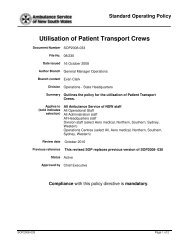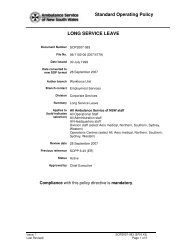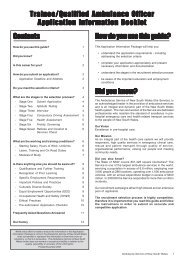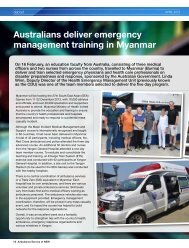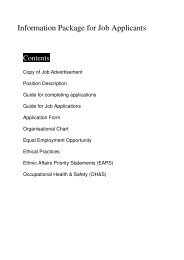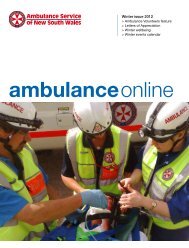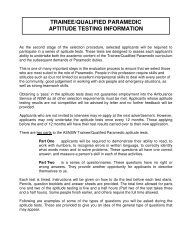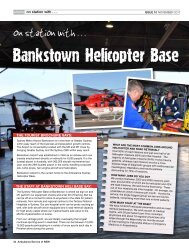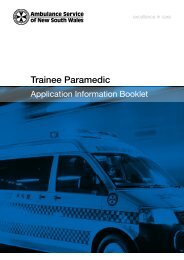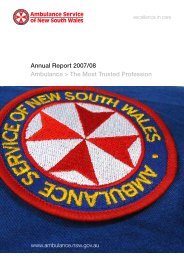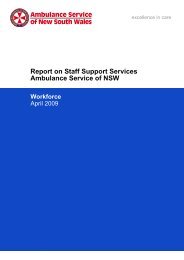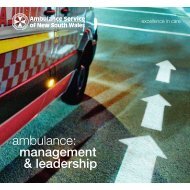atsb final report released 16 may 2013 - Ambulance Service of NSW
atsb final report released 16 may 2013 - Ambulance Service of NSW
atsb final report released 16 may 2013 - Ambulance Service of NSW
You also want an ePaper? Increase the reach of your titles
YUMPU automatically turns print PDFs into web optimized ePapers that Google loves.
advised the ACM to communicate using hand signals. There was no indication onthe MPFR that the winch-mounted lights were extinguished at that point, whichwould have indicated to the duty paramedic that hand signals were to be used (seethe section titled Helicopter operator).At 20:37:55, the pilot asked the ACM what the duty paramedic was doing with theropes. Two seconds later, the ACM replied that he couldn’t see as the paramedicwas ‘...in a dark hole...’. The pilot acknowledged and at 20:38:05, the ACM advisedthe pilot that he had received a hand signal from the duty paramedic indicating thathe and the patient were ready to be winched.At 20:38:07 the ACM advised the pilot that he intended to winch in the slack in thecable and direct the helicopter closer to the intended winching position prior toactually lifting the patient and paramedic. The MPFR recorded the ACM stating at20:38:15 that he was ‘winching in the slack [in the winch cable]’ and, at 20:38:23,the ACM again announcing that he was ‘winching in the slack’. The ACM alsoinstructed the pilot to ‘Go up 20’ at that time. The operations manual stated that,with regard to distance directions to a pilot by an ACM:Once established in the hover all lateral, height and obstacle clearanceinformation is to be given in ‘feet’.In that context, the instruction to the pilot was intended to climb the helicopter 20 ft,or about 6 m.The ACM <strong>report</strong>ed that a short time later the duty paramedic and patient appearedto move out from the ledge in a controlled manner however, after about 2 m <strong>of</strong>horizontal movement the ACM assessed that what he perceived as the redstabilising rope appeared to fail. The patient and paramedic fell several metres ontoa lower ledge before swinging towards a position under the helicopter. In response,the ACM winched in the cable at full speed and directed the pilot to move thehelicopter left. The ACM recalled that he was concerned that the patient and dutyparamedic might swing back and contact the rock ledge. However, during the initialswing from the ledge towards the helicopter, they impacted a second rock at thebase <strong>of</strong> the waterfall that was displaced about 26 m laterally and 15 m verticallydown from the rock ledge and came to rest (Figure 7).The MPFR recorded the ACM advising the pilot that the paramedic and patientwere coming <strong>of</strong>f the ledge at 20:38:31. Three seconds later, the ACM announcedthat he was winching in and that the duty paramedic and patient had fallen from theledge, and instructed the pilot to ‘move [the helicopter] left 5 [ft]’. None <strong>of</strong> theoperator’s standard voice commands associated with the commencement <strong>of</strong> thewinch or the actual lift itself (see the section titled Helicopter operator) wererecorded on the MPFR prior to the fall.In the time between when the ACM instructed the pilot to climb the helicopter andwhen he announced that the patient and paramedic were coming <strong>of</strong>f the ledge, thehelicopter climbed about 2 m to a height <strong>of</strong> about 43 m above the base <strong>of</strong> thewaterfall.- 10 -



